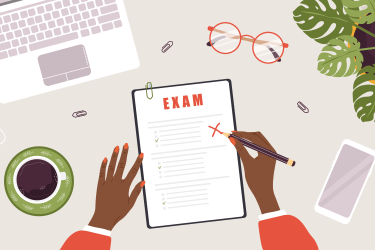Links like this one flooded the web recently.
Do you think your students would click on it? Do you think they already did?
The reasons behind the plagiarism may vary from knowingly copying, to taking the excerpts of someone else’s work by mistake. You can check the plagiarism stories of real students to get the thinking behind this behavior. Procrastination and the lack of time are the main culprits, of course. But few stories ventilate more preventable reasons, like ignorance, fail to check sources, or confusing assignment.
The first thing you need to do is tell your students that plagiarism is prohibited – loud and clear. Also, make sure it is prohibited by the Academic Integrity Policies of your school. After that, educate your students about what is considered plagiarism and how they can avoid it.
Below you’ll find some good recommendations for the teachers on what exactly can be done to prevent the plagiarism.
How to detect plagiarism?
- Use the plagiarism checking software. Always! Pick carefully, as most of the popular and widely available checkers had been on the market long enough for the cheating businesses to find the ways to slip through. Not all software provides equally high quality of the check, too. Consider using more than one tool for the sake of being confident. The Plagiarismcheck is highly credible and recommended by hundreds of teachers.
- Keep your tone-of-voice detector in a good working mode. Of course it is a challenge to remember the capabilities of each and every student on your course. Yet you can do it. Use in-class writing to get some tangible proofs of your students style and tone-of-voice. The rule of thumb: if something is too good to be true, than it probably is not.
- Check the properties of the paper. As you get the document submitted, download it and right-click to open the file properties. It will give you the name of the file creator, time of most recent edits etc. Keep in mind, that it’s not the ultimate evidence – as your student could borrow a laptop from friend, copy the file from somewhere, or simply delete the metadata. If you have doubts, that would be a good incentive to initiate a conversation with the student.
- Talk to your student. Ask students about their writing – how was the process, what difficulties they experiences, what were their favorite ideas, how long did they spend on writing.
- Get second opinion. If you’re still suspicious about the case, make sure to ask a colleague for a second opinion before transferring the case to the Academic Integrity Office.
How to prevent plagiarism?
- Be more creative with the assignments. Canned assignments make life easier for the teacher, but for the students as well. The web is full of ready-made answers for the tests and exams, by far essays. Spend some time on producing unique, customized, up-to-date essay topics that will actually dazzle your class. Consider doing this together with your students for the maximum engagement.
- Give more flexibility. Try reducing the number of non-substantive requirements for the paper, namely the minimum number of words or pages. In a rush to meet these criteria students fluff up their writings with unnecessary data, or go to the essay providers.
- Reduce the deadline pressure. However radical that may sound – allow for late submissions. Of course, the deadlines are important for the discipline. Yet, some wiggle space might keep those of your students who have to work and keep families from resorting to cheating services.
- Use in-class writing and drafting. Working on the prompt in the class is a great solution for the multiple reasons. First, students get the chance to understand the assignment better, brainstorm ideas right away, and ask you questions. Second, you get to sneak a peek into their thinking, and collect written drafts to see if they develop similar messaging in their essays later.
- Provide proctored assignments. In classes where the writing is ultimate part of the subject, at least one proctored exam per course is required. It doesn’t have to have a great impact on the grade percentage, but it has to be mandatory for passing the course.
There are multiple ways to detect and prevent the plagiarism in essays. Integrate them as a part of your daily teaching routine, and it’ll surely benefit you and your students alike.
Image credit:https://www.flickr.com/photos/psutlt/7008550809/ Penn State TLT








